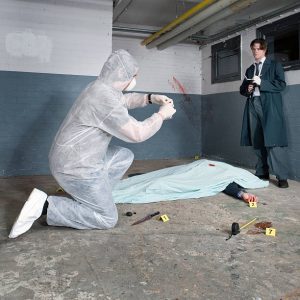| Blood Spatter Analyst Key Stats | |
|---|---|
| Avg. Salary / year | $65,320 |
| Avg. Pay / hour | $31.41 |
| Education | 4+ Years |
| Job Outlook | 14% |
| Total Employed | 343,040 |
Blood Spatter Analysts are specialized individuals who work with other professionals such as law enforcement and forensic scientists to solve a variety of homicides or other violent crimes.
Individuals who want to become a Blood Spatter Analyst may find themselves having a passion for solving crimes and working with law enforcement to help solve them.
Individuals who join this profession must have a strong attention to detail as the information they gather from a crime scene is used to solve serious violent crimes.
The attention to detail is so important, that some forensic evidence is not visible to the human eye and must be observed in a laboratory setting.
Go to Page Section:
Education Requirements to Become a Blood Spatter Analyst
In order for an individual to become a Blood Spatter Analyst, they must first seek a bachelor’s degree from an accredited college or university.
Although a specific major or degree is not required, an individual can opt to focus their major in Criminal Justice or Forensic Science to help them prepare for a career as a Blood Spatter Analyst.
During their college career, an individual who wants to become a Blood Spatter Analyst must take a variety of classes to help them understand the human body such as anatomy and biology.
In addition, individuals must also take classes in constitutional law, criminology and statistical analysis to understand the technical terms needed for this job.
Furthermore, individuals need to take specialized classes to learn more detailed information on blood and forensics.
Such classes will give in depth information on blood, crime scene reconstruction, location and movement as well as the type of damage certain types of weapons will cause.
For example, a criminal using a knife to commit a crime will leave behind different evidence than an individual using a shotgun or gun.
Blood Spatter Analyst Job Description
Professionals working as a Blood Spatter Analysts can take pride in the fact that their daily job duties are essential in assisting law enforcement and other crime solving professionals.
Their line of work is geared to helping these professionals solve a variety of violent crimes or murders.
Blood Spatter Analysts begin working on a crime when they first receive blood samples in their laboratory.
Depending on the quantity and quality of forensic evidence gathered at the scene, Blood Spatter Analysts have the task of analyzing any amount of evidence collected at the scene.
For example, some crimes or violent actions may not create a lot of blood, but with the evidence and samples gathered, Blood Spatter Analyst will still be required to examine any amount of blood samples, no matter how small it is.
A Blood Spatter Analyst’s skills in attention to detail are of utmost importance when receiving a small amount of blood to analyze.
On the other hand, Blood Spatter Analysts may also run into the opposite and have a large amount of blood to analyze.
For trace amounts of blood, these professionals may have to use complicated tools such as Ultraviolet light to detect a small amount of blood at a crime scene.
Their attention to detail may also help solve cases in which a violent act or crime was covered up or cleaned after the fact.
In these cases, UV lights will also be used to track traces of DNA and blood.
Blood Spatter Analyst Salary and Career Path
The median income for Forensic Technicians, which includes the Blood Spatter Analyst profession was approximately $52,840 in 2012.
The job outlook for this industry is expected to grow by 6 percent through the year 2022 which is considered slower than average when compared to other professions and fields.
The interest for forensic science has increased due to its exposure on popular television.
Because of this, the competition for jobs in this field has tightened as well.
However, individuals with advanced Master’s degree in Forensic Science or a Bachelor’s in Natural Science will have the best prospects for jobs.
Individuals who are interested in this profession, will also benefit by looking into similar professions such as a Forensic Scientist, Crime Laboratory Analyst or in the criminal justice field to increase their chances of working in this profession.
![]() The below information is based on the 2024 BLS national averages.
The below information is based on the 2024 BLS national averages.
National Average Salary
$65,320Average Salary by State
| State | Avg. Annual Salary |
|---|---|
| Alabama | $51,440 |
| Alaska | $71,590 |
| Arizona | $66,740 |
| Arkansas | $53,770 |
| California | $76,690 |
| Connecticut | $75,690 |
| Delaware | $70,570 |
| District of Columbia | $81,630 |
| Florida | $60,920 |
| Georgia | $65,430 |
| Hawaii | $70,030 |
| Idaho | $54,110 |
| Illinois | $68,680 |
| Indiana | $58,450 |
| Iowa | $57,110 |
| Kansas | $61,770 |
| Kentucky | $59,990 |
| Louisiana | $57,130 |
| Maine | $66,540 |
| Maryland | $63,210 |
| Massachusetts | $72,960 |
| Michigan | $60,650 |
| Minnesota | $73,840 |
| Mississippi | $50,420 |
| Missouri | $60,210 |
| Montana | $67,120 |
| Nebraska | $63,270 |
| Nevada | $63,600 |
| New Hampshire | $78,350 |
| New Jersey | $69,350 |
| New Mexico | $53,670 |
| New York | $86,300 |
| North Carolina | $59,800 |
| North Dakota | $62,700 |
| Ohio | $62,730 |
| Oklahoma | $57,210 |
| Oregon | $78,530 |
| Pennsylvania | $62,120 |
| Rhode Island | $82,450 |
| South Carolina | $55,760 |
| South Dakota | $58,220 |
| Tennessee | $59,280 |
| Texas | $59,030 |
| Utah | $55,200 |
| Vermont | $76,110 |
| Virginia | $64,790 |
| Washington | $73,280 |
| West Virginia | $60,080 |
| Wisconsin | $64,470 |
| Wyoming | $67,600 |
| Puerto Rico | $39,190 |
| Virgin Islands | $58,740 |
The highest-paying state in this field is New York, with an average salary of $86,300.
Here are the five states with the highest salaries in the field:
* Employment conditions in your area may vary.
Frequently Asked Questions
What is a Blood Spatter Analyst?
Blood spatter analysts are forensic science technicians specialized in collecting and analyzing blood evidence.
They examine the location and shape of bloodstains in order to help detectives and investigators solve cases.
Blood spatter analysts take photographs, collect, catalog and preserve evidence, write reports and testify in court.
Blood spatter analysts who investigate crime scenes may work day, night or evening hours and may have to work overtime because they must be available to collect and analyze evidence.
Those who work in laboratories usually work normal business hours but they may also have to be on-call if they are needed to work immediately on a case.
How much does a Blood Spatter Analyst make?
Blood spatter analysts are forensic science investigators.
According to the Bureau of Labor Statistics, forensic science investigators earned an annual salary of 58,230 in May of 2018.
Annual wage varies depending on the employer and the level of experience.
The top 10% earn around $97,200 per year while the bottom 10% earn around $34,600.
How much does it cost to become a Blood Spatter Analyst?
Blood spatter analysts need a bachelor’s degree in biology, chemistry or similar field.
The cost of earning a bachelor’s degree can range anywhere between a little over $11,000 to more than $50,000.
Tuition costs vary depending on the chosen college or university.
If you want to have better job prospects you should also consider getting a master’s degree.
A master’s degree program costs, on average between $20,000-$30,000 per year.
Certification requirements for forensic science technicians vary by state.
The certifications are offered by the International Association for Identification and by the American Board of Criminalistics.
What is the demand for Blood Spatter Analysts?
The US Board of Labor Statistics doesn’t record data about blood spatter analysts but they track job demand data about forensic scientists.
The demand for forensic science technicians is expected to grow 14 percent between 2018-2028, much faster than the demand for all other occupations.
The reliability and usefulness of objective forensic information used in trials are expected to grow even more in the future thanks to scientific and technological advances.
Therefore, more forensic scientists will be needed to provide forensic information.
The competition for this type of job is expected to be strong, this is why you should also consider getting a master’s degree in order to have an advantage over the other candidates.
How long does it take to become a Blood Spatter Analyst?
Blood spatter analysts, as all forensic science technicians need at least a bachelor’s degree in chemistry, biology or forensic science.
Getting your degree can take 3-4 years, depending on college and program.
If you want to have better chances at getting a job in this field, you should also get your master’s degree.
Master’s degree programs can be completed, on average, in 1.5-2 years by full-time students.
After being hired, you may also receive additional on-the-job training while working under the supervision of an experienced analyst.
It can take up to 3 years until you’re ready to handle cases on your own.














